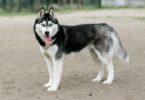What makes the brown-coated Siberian Husky a unique companion that demands more than just casual attention? This striking variation of a popular Arctic breed combines wolf-like beauty with a spirited personality, but its needs go far beyond aesthetics.
This guide explores everything from their thick double coat to their high-energy temperament. You’ll learn why these athletic dogs thrive on structured routines and mental challenges. Topics include health considerations like hip dysplasia prevention, grooming during seasonal shedding, and exercise strategies tailored to their endurance.
Whether you’re considering adoption or optimizing care for your current pet, understanding this breed’s history as sled-pulling champions explains many modern behaviors. Discover how proper nutrition and technology like GPS collars address their escape-artist tendencies. By the end, you’ll have actionable insights to build a fulfilling life with your four-legged partner.
Introducing the Brown Husky
Few breeds command attention like the brown-coated Husky, a living blend of Arctic heritage and modern charm. These dogs stand out with coats ranging from warm auburn to deep mahogany, often paired with mesmerizing blue or heterochromatic eyes. Their wolf-like features create an unforgettable first impression, balanced by an approachable demeanor that defies their wild appearance.
Beyond their striking looks, these canines bring relentless enthusiasm to every interaction. Owners often describe them as “four-legged comedians” due to their playful antics and love for interactive games. Their social nature makes them thrive in active households where they can participate in family adventures.
What truly sets this breed apart is its dual appeal. While their athletic build hints at sled-pulling ancestry, their affectionate temperament shines through in quiet moments. They form strong bonds with owners yet maintain an independent streak—a testament to their working dog roots. Proper care channels their energy into positive outlets, creating harmony between their spirited personality and domestic life.
A Rich Heritage of Brown Huskies
Centuries of Arctic survival shaped this breed’s legacy long before they became household companions. Their story begins with the Chukchi tribe in Siberia, who selectively bred ancestors of today’s brown-coated Huskies for unmatched stamina and cold tolerance. These early dogs weren’t just workers—they were family members, sharing food and shelter with their human partners.
Historical Origins and Lineage
The Chukchi people needed dogs that could haul light loads across frozen terrain for days. By the 1800s, their breeding program produced animals capable of traveling 100+ miles daily in -50°F temperatures. DNA studies reveal these dogs share genetic markers with ancient Siberian wolves, explaining their robust build and weather-resistant double coats.
The Role in Sled Dog Culture
During Alaska’s 1925 serum run, teams dominated by Husky-lineage dogs saved a town from diphtheria by delivering medicine through a blizzard. This event cemented their reputation as elite sled dogs. Modern racing teams still favor their descendants for maintaining speeds of 10–12 mph over 30-mile stretches—a direct link to their working roots.
Today’s brown Huskies inherit more than physical traits. Their cooperative nature stems from generations of teamwork, while their vocalizations echo the Chukchi’s reliance on canine communication. Owners often describe an unspoken understanding that bridges species—a bond forged through millennia of shared challenges.
Distinctive Appearance and Unique Traits
The visual signature of this Arctic-bred canine goes far beyond superficial beauty. Every physical feature reflects generations of adaptation, blending striking aesthetics with functional design. Owners quickly discover these dogs are living examples of form meeting purpose.
Coat Colors and Textures
Warm auburn to rich mahogany hues create a mesmerizing palette across their thick double-layered fur. This coat serves as natural insulation, trapping body heat during freezing temperatures while reflecting sunlight in summer. The outer guard hairs repel moisture, while the soft undercoat maintains consistent warmth.
Standing 20–24 inches tall at the shoulder, these medium-sized athletes carry a balanced frame built for endurance. Their compact yet muscular build allows sudden bursts of speed without sacrificing agility. This structural efficiency stems from centuries of selective breeding for sled-pulling efficiency.
Expressive Eyes and Build
Almond-shaped eyes ranging from icy blue to warm amber create an arresting gaze that seems to peer into your thoughts. Some display heterochromia—a captivating mix of colors in each eye—enhancing their magnetic presence. These features evolved to reduce snow glare while maintaining visual acuity in harsh environments.
Subtle traits complete their distinctive nature. Tightly furled tails protect sensitive noses during snow naps, while paw pads contain anti-freeze proteins. Even their vocalizations—a mix of howls and “talking” sounds—reflect their communicative heritage as working partners.
Understanding the Temperament of Brown Huskies
Navigating the personality of these Arctic-bred canines reveals a fascinating mix of charm and challenge. Their intelligence shines through problem-solving skills, while their social nature makes them eager participants in family life. However, this breed’s working heritage surfaces in unexpected ways that demand thoughtful handling.
Behavioral Traits and Energy Levels
Owners often describe these dogs as affectionate comedians with a stubborn streak. They’ll enthusiastically learn new tricks but might ignore commands when distracted by interesting scents. This independence stems from centuries of making quick decisions during sled runs—a trait that persists in modern companions.
Daily routines require careful planning. A bored canine may invent games involving shredded pillows or escape attempts. Structured exercise channels their endurance into positive outlets like agility courses or interactive puzzles. Mental stimulation proves equally vital—food-dispensing toys or scent work prevent destructive habits.
Early socialization shapes their interactions profoundly. Puppies exposed to varied environments adapt better to strangers and other pets. Without proper guidance, their prey drive might surface during walks, turning squirrels into irresistible targets. Consistent training using positive reinforcement builds trust while managing their spirited nature.
Vocalizations range from conversational “woos” to full-blown howls during play. These communicative sounds reflect their pack mentality, often escalating when left alone too long. Understanding these signals helps owners create balanced routines that honor the breed’s needs and quirks.
Health Essentials for Your Brown Husky
Maintaining optimal health in these energetic canines requires a proactive approach to their unique needs. Their active lifestyle and thick coats demand tailored care strategies that address both physical and mental well-being.
Fueling Vitality Through Nutrition
High-quality protein-rich food supports muscle maintenance in athletic dogs. Measure portions using a standardized cup to prevent overfeeding—adults typically need 2-3 cups daily split into two meals. Incorporate omega fatty acids for coat health and joint supplements for active joints.
Regular weigh-ins help track body condition. Ideal weight ranges between 35-60 pounds depending on gender and frame. Combine controlled feeding with 60+ minutes of daily exercise like hiking or agility training to maintain lean muscle mass.
Preventative Measures for Longevity
Annual vet exams catch potential issues early, from dental concerns to genetic conditions. Core vaccinations protect against rabies, distemper, and parvovirus. Discuss region-specific risks like Lyme disease with your veterinarian.
Monthly preventatives guard against heartworms and parasites. Grooming sessions double as health checks—inspect paws for cracks and ears for redness. With proper care, these spirited companions often enjoy 12-15 years of adventurous life.
Grooming and Coat Care Tips
A well-groomed coat isn’t just about looks—it’s vital for your dog’s health and comfort. Regular maintenance prevents matting, distributes natural oils, and reduces allergens in your home. It also lets you spot skin issues early, from dryness to parasites.
Managing Seasonal Shedding
These dogs experience heavy shedding twice yearly as their undercoat renews. Use an undercoat rake 3-4 times weekly during peak seasons to remove loose fur. Follow with a slicker brush to smooth the topcoat, working in sections from neck to tail.
Bathe every 8-12 weeks using oatmeal-based shampoo to preserve skin moisture. Always dry thoroughly with a high-velocity dryer to prevent mildew in dense fur. Trim nails monthly with guillotine-style clippers, stopping before the pink quick visible in light-colored claws.
Complete care includes dental hygiene. Brush teeth twice weekly with enzymatic paste and offer dental chews to reduce plaque. Pair grooming sessions with treats to create positive associations, keeping routines efficient and stress-free.
Exercise, Play, and Daily Activity Needs
Meeting the activity requirements of Arctic-bred dogs creates a rewarding partnership built on movement and engagement. These athletic companions thrive when given 90-120 minutes of structured exercise daily, channeling their endurance into purposeful challenges. A balanced routine combines physical exertion with cognitive tasks to satisfy their working heritage.
Outdoor Adventures and Hiking
Trail exploration offers ideal stimulation for dogs bred to traverse vast landscapes. Aim for 3-5 mile hikes over varied terrain, using harnesses designed for pulling motions. Morning and evening sessions help avoid overheating while maintaining their natural rhythm.
Consider incorporating weight-pulling activities during walks using specially designed sled dog harnesses. This engages their historical muscle memory while burning energy efficiently. Always carry collapsible water bowls and check paw pads after rocky excursions.
Engaging Games for Mental Stimulation
Interactive puzzle toys filled with frozen kibble mixtures turn mealtime into brain workouts. Rotate different challenge levels weekly to prevent mastery boredom. Hide-and-seek games using scented objects leverage their superior tracking instincts.
Agility courses in secure yards provide dual benefits. Set up weave poles and A-frames to test coordination while reinforcing obedience commands. End each session with calm grooming to transition energy levels smoothly.
Structured routines prevent destructive habits. Alternate hiking days with scent work sessions and swimming for low-impact variety. Monitor enthusiasm during activities—these determined athletes might push beyond reasonable limits without self-regulation.
Training Your Brown Husky: Techniques for Success
Training these intelligent canines requires balancing their quick learning abilities with creative strategies for their strong-willed nature. A structured approach builds trust while respecting their independent streak. Start with short 10-minute sessions to maintain focus, pairing verbal praise with high-value treats like freeze-dried liver.
Building Cooperation Through Rewards
Positive reinforcement works best when rewards follow desired actions within 1.3 seconds. Use marker words like “Yes!” to pinpoint good behavior instantly. For expert puppy training advice, focus on foundational commands like “sit” and “stay” before advancing to complex tasks.
Consistency transforms sporadic obedience into reliable habits. Always use the same hand signals and verbal cues. Practice “heel” during walks by stopping when they pull, resuming only when leash tension eases. This teaches self-control through clear cause-and-effect relationships.
Turning Challenges Into Progress
When faced with resistance, switch to interactive games that disguise learning. Hide treats under cups for scent-based puzzles, rewarding correct choices enthusiastically. If commands get ignored, reduce distractions by moving to quieter spaces before reintroducing challenges.
Mental stimulation proves crucial—rotate puzzle toys weekly to prevent boredom. Combine physical exercise with training by incorporating “find it” games during hikes. Celebrate small victories to keep sessions positive, building confidence that counters stubborn tendencies naturally.
Socializing Your Brown Husky with Family and Pets
Building positive relationships starts with smart socialization strategies. Early exposure to diverse experiences helps these energetic dogs adapt to family life. Begin introductions during puppyhood when curiosity outweighs caution.
Creating Child-Friendly Bonds
Teach children gentle interaction techniques before meetings. Use leashed sessions with treats to reward calm behavior. Supervise play to prevent tail-pulling or sudden movements that might trigger instinctive reactions.
Gradually increase exposure to school-aged kids through short, structured visits. Pair positive reinforcement with activities like fetch to build trust. This approach reduces anxiety while reinforcing desired social habits.
Harmonizing Multi-Pet Households
Introduce new animals in neutral spaces to minimize territorial behavior. Start with scent exchanges using blankets before face-to-face meetings. Watch for relaxed body language like loose tails and soft eyes.
Manage prey drive through distraction techniques during encounters with smaller pets. Redirect attention using squeaky toys or obedience commands. Consistent training sessions strengthen impulse control over time.
Controlled group walks help establish pack dynamics safely. Reward polite interactions with praise to cement good manners. Successful socialization creates confident companions who thrive in active homes.
Safety, Accessories, and Modern Technology
Today’s pet care combines innovative tools with time-tested methods to protect adventurous dogs. Advanced collars and tracking systems offer peace of mind for owners managing energetic breeds. These solutions work alongside traditional training to create layered safety nets.
Fi Dog Collar and GPS Tracking
The Fi Smart Collar provides real-time location updates via GPS, crucial for dogs prone to exploration. Its geofencing feature alerts owners if pets leave designated areas like yards or hiking trails. With military-grade durability and a 12-hour battery, it withstands rough outdoor use.
This collar’s 360° visibility up to 1/4 mile helps locate dogs quickly during escapes. Pair it with training to reinforce boundaries—reward your pet for staying within virtual fences. Many owners report faster recoveries thanks to precise tracking data.
Microchipping and Escape Prevention
Microchips serve as permanent identification if collars fail. Shelters and vets scan these rice-sized implants to reunite lost pets with families. Combine this with updated registration details for maximum effectiveness.
Choose accessories that complement safety tech. Reflective collars enhance visibility at night, while GPS units integrate with smartphone apps. Always prioritize comfort—adjustable designs prevent chafing during high-energy activities.
Real-world examples show how these tools save lives. One family recovered their dog 15 miles away using location history from their tracking collar. Another owner credits microchip scanning for their pet’s return after a cross-state adventure.
Addressing Common Behavioral Issues
Why do intelligent, energetic dogs sometimes develop challenging habits? Many active breeds exhibit behaviors like excessive howling or digging when their physical and mental needs go unmet. Understanding these actions as communication—not disobedience—creates opportunities for positive change.
Vocal outbursts often stem from boredom or pent-up energy. A dog left alone for hours might “sing” to express frustration. Similarly, relentless digging frequently signals inadequate exercise or unmet instinctual drives. Escape attempts usually occur when dogs crave stimulation beyond their current environment.
Practical Solutions for Lasting Results
Start with structured 45-minute exercise sessions twice daily. Combine jogging with puzzle toys that reward problem-solving. For persistent howling, teach the “quiet” command using treats when barking stops. Create a designated digging zone filled with loose soil or sand to redirect this natural behavior.
Technology like GPS collars adds an extra layer of control for escape-prone pets. These devices alert owners when dogs approach boundary limits. Pair tech tools with consistent training to reinforce desired behaviors. One owner reduced digging by 80% using scheduled playtimes and a sandbox “dig pit.”
Early intervention prevents habits from becoming ingrained. Most issues improve within 4-6 weeks using reward-based methods. Remember—patience and routine transform challenging behaviors into manageable quirks. Your efforts build trust while honoring your companion’s spirited nature.
Embracing Life with a Brown Husky
Living with an Arctic-bred companion offers both challenges and unforgettable rewards. This spirited breed thrives when owners combine their historic needs with modern care strategies. From protein-rich diets to structured playtime, every choice shapes a fulfilling partnership.
Proper nutrition fuels their adventurous nature. High-quality food supports muscle health, while measured portions prevent weight issues. Pair meals with interactive feeding toys to engage their problem-solving skills naturally.
Regular exercise and grooming form the foundation of daily care. These athletic dogs need activities that mirror their sled-pulling heritage—think hiking or agility courses. Their iconic coat demands weekly brushing, especially during seasonal shedding cycles.
Training and socialization transform energetic pups into well-adjusted family members. Consistent routines build trust while honoring their independent streak. Modern tools like GPS collars add safety during outdoor adventures.
By following this guide, families create homes where these intelligent canines flourish. Their loyalty and playful nature enrich households ready for active companionship. With informed care, the journey becomes a shared story of growth and joy.
FAQ
How much exercise do these dogs need daily?
They thrive with 60–90 minutes of vigorous activity like hiking or running. Mental stimulation through puzzle toys or agility courses helps prevent boredom-driven behaviors.
Are they prone to specific health issues?
Common concerns include hip dysplasia and eye conditions like cataracts. Regular vet visits, joint supplements, and a high-protein diet support long-term wellness.
What’s the best way to manage their shedding?
Brush their double coat 2–3 times weekly using an undercoat rake. During seasonal shedding (spring/fall), daily grooming with a deshedding tool minimizes loose fur around your home.
Can they live comfortably in warm climates?
Yes, with precautions. Provide shaded outdoor areas, limit midday exercise, and ensure constant access to water. Indoor cooling mats or air conditioning help regulate their body temperature.










Leave a Comment